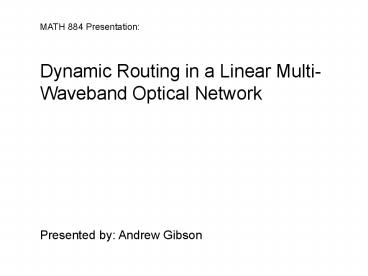MATH 884 Presentation: - PowerPoint PPT Presentation
1 / 15
Title:
MATH 884 Presentation:
Description:
Inseparability (VERY IMPORTANT CONCEPT) Mutually Independent Sources Combining (MISC) ... This unintended multicasting is a result of inseparability. ... – PowerPoint PPT presentation
Number of Views:47
Avg rating:3.0/5.0
Title: MATH 884 Presentation:
1
MATH 884 Presentation Dynamic Routing in a
Linear Multi-Waveband Optical Network Present
ed by Andrew Gibson
2
1
1
C
A
F
B
G
2
H
E
D
3
2
3
Example of an optical network.
3
- Properties of Linear Optical Networks
- Linear operations vs. non-linear operations
- Graph Construction
- LDCs
- Wavebands
- Assumptions
4
Optical Spectrum
Channel 2
Channel 2
Channel 1
Channel 1
Waveband 1
Waveband 2
5
- Restrictions on Linear Optical Networks
- Channel Continuity
- Distinct Channel Assignment
- Inseparability (VERY IMPORTANT CONCEPT)
- Mutually Independent Sources Combining (MISC)
- Color Clash
6
1
1
C
S1
S1
S1
S1
S1
S1
A
F
B
G
2
H
E
D
3
2
3
Now add path (2,2) 2-A-B-D-E-2 on the same
waveband as (1,1) but a different channel (dont
violate Distinct Waveband-Channel
Assignment) Note this is the min-hop path
7
1
1
C
S1S2
S1
S1S2
S1S2
S1S2
A
F
B
G
S1S2
S1S2
S2
2
H
E
D
3
S1S2
S1S2
2
3
This unintended multicasting is a result of
inseparability. Note S1 and S2 are interfering
signals.
8
- Where are we now?
- Intro to Linear Optical Networks
- Properties of Linear Optical Networks - DONE
- Restrictions within Linear Optical Networks -
DONE - Where next?
- Introduce and decompose routing problem
- Waveband selection
- Path selection
- Conclusions
9
- Routing Problem
- Choose a Waveband for the incoming call
- Finding a Path within a selected Waveband
- Checking for violations of network constraints
- Assigning the Channel or blocking the signal.
10
- Choose a Waveband for a selected call
- Two different rules for choosing a Waveband
MAXBAND and MINBAND - Let (Wb1, .. , Wbk) be the k different wavebands
on the links
11
Finding a Path within a selected
Waveband Theorem 1 Finding a path, within a
chosen Waveband, form a
source transmitter s to destination receiver t
that satisfies the MISC constraint on it
as well as all associated unintended
paths due to inseparability is
NP-Complete. Theorem 2 A polynomial time
algorithm exists which can find a path from
a source s to a destination t, within a chosen
Waveband that satisfies the Color Clash
constraint on it as well as all associated
unintended paths.
12
- Finding a Path within a selected waveband
- Min-Int
- Definitions
- An internodal link from node i to node j will be
denoted by (i,j) and it can be assigned any
weight as with the K-SP algorithm - An intranodal link inside node k joining inbound
link (i,k) and (k,j) will be assigned a weight - Ik(i,j) M G(k , j) G(i , k)
- Where G(k , j ) the set of signals carried
on link ( k , j) - Complexity O ( m log(n))
- Where m is the number of links in the network
and n is the number of nodes
13
Checking for violations of network
constraints Recursive algorithm with complexity
of O(m)
14
- Assigning the Channel or blocking the signal
- If a path can be provided then a Channel within
the selected waveband must be used. - The same algorithm for selecting wavebands is
used for selecting the individual Channels.
15
Conclusions One algorithm has been proposed for
accomplishing the task of dynamic routing within
a linear optical network. The worst case
complexity is O(k m m log(n))































